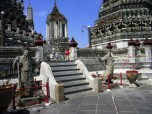Wat Bowonniwet Vihara is among the most important Buddhist temples, or wats, in Thailand. It stands in the Bangkok district of Phra Nakhon, and is an important center for Thai Theravada Buddhism, in particular the school of Thammayut Nikaya. The temple has a long history of patronage by the Chakri dynasty, the current royal house of the country. It has served as a major temple for many years.
History and Background
The ashes of many members of the Thai royal family, together with their relics, are held in the shrine of the wat. The shrine is also home to one of the most magnificent Buddha statues in Thailand. This Buddha, which is known as Phra Phutthachinasi, dates from 1257 and was created as part of the celebrations in that year after the Thais won a notable victory over the Khmers.
Although the wat also contains a pair of viharas, or refuges originally used as dwellings by monks in the rainy months, these are not open for public inspection. The shrine is also noted for its fine carving of Buddha’s footprints. The double example at the wat is more than ten feet in length and carved into one large block of stone.
Patronage by royalty
The first abbot, or monastery leader, of the wat was Prince Mongkut, who began his tenure in this role in 1836. Mongkut took the name of Vajiranano while at the monastery, and was the founder of the sect of Thai Buddhism known as Thammayut. He later became the King of Thailand, and reigned as Rama IV.
Since the 19th century, both kings and princes of Thailand have completed periods of study at the wat. These include the current King of Thailand, Bhumibol Adulyadej, otherwise known as Rama IX. The heir apparent to the Thai throne, Prince Vajiralongkorn, was also ordained as a monk, although the period that he spent at this temple was short by comparison with some of his predecessors.

































